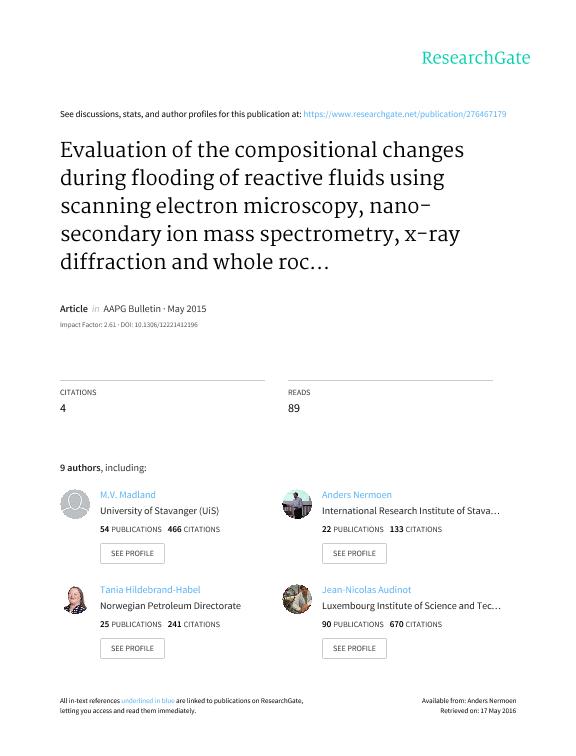Artículo
Evaluation of the compositional changes during flooding of reactive fluids using scanning electron microscopy, nano-secondary ion mass spectrometry, x-ray diffraction, and whole-rock geochemistry
Zimmermann, Udo; Madland, Merete Vadla; Nermoen, Anders; Hildebrand Habel, Tania; Bertolino, Silvana Raquel Alina ; Hiorth, Aksel; Korsnes, Reidar I.; Audinot, Jean-Nicolas; Grysan, Patrick
; Hiorth, Aksel; Korsnes, Reidar I.; Audinot, Jean-Nicolas; Grysan, Patrick
 ; Hiorth, Aksel; Korsnes, Reidar I.; Audinot, Jean-Nicolas; Grysan, Patrick
; Hiorth, Aksel; Korsnes, Reidar I.; Audinot, Jean-Nicolas; Grysan, Patrick
Fecha de publicación:
05/2015
Editorial:
American Association of Petroleum Geologists
Revista:
AAPG Bulletin
ISSN:
0149-1423
Idioma:
Inglés
Tipo de recurso:
Artículo publicado
Clasificación temática:
Resumen
Outcrop chalk of late Campanian age (Gulpen Formation) from Liège (Belgium) was flooded with MgCl2 in a triaxial cell for 516 days under reservoir conditions to understand how the nonequilibrium nature of the fluids altered the chalks. The study is motivated by enhanced oil recovery (EOR) processes because dissolution and precipitation change the way in which oils are trapped in chalk reservoirs. Relative to initial composition, the first centimeter of the flooded chalk sample shows an increase in MgO by approximately 100, from a weight percent of 0.33% to 33.03% and a corresponding depletion of CaO by more than 70% from 52.22 to 14.43 wt.%. Except for Sr, other major or trace elements do not show a significant change in concentration. Magnesite was identified as the major newly grown mineral phase. At the same time, porosity was reduced by approximately 20%. The amount of Cl- in the effluent brine remained unchanged, whereas Mg2+ was depleted and Ca2+ enriched. The loss of Ca2+ and gain in Mg2+ are attributed to precipitation of new minerals and leaching the tested core by approximately 20%, respectively. Dramatic mineralogical and geochemical changes are observed with scanning electron microscopyenergy-dispersive x-ray spectroscopy, nano secondary ion mass spectrometry, x-ray diffraction, and whole-rock geochemistry techniques. The understanding of how fluids interact with rocks is important to, for example, EOR, because textural changes in the pore space affect how water will imbibe and expel oil from the rock. The mechanisms of dissolution and mineralization of fine-grained chalk can be described and quantified and, when understood, offer numerous possibilities in the engineering of carbonate reservoirs.
Palabras clave:
Oil Recovery
,
Flooded Chalk
,
Nano-Sims
,
Geochemistry
Archivos asociados
Licencia
Identificadores
Colecciones
Articulos(IFEG)
Articulos de INST.DE FISICA ENRIQUE GAVIOLA
Articulos de INST.DE FISICA ENRIQUE GAVIOLA
Citación
Zimmermann, Udo; Madland, Merete Vadla; Nermoen, Anders; Hildebrand Habel, Tania; Bertolino, Silvana Raquel Alina; et al.; Evaluation of the compositional changes during flooding of reactive fluids using scanning electron microscopy, nano-secondary ion mass spectrometry, x-ray diffraction, and whole-rock geochemistry; American Association of Petroleum Geologists; AAPG Bulletin; 99; 5; 5-2015; 791-805
Compartir
Altmétricas



